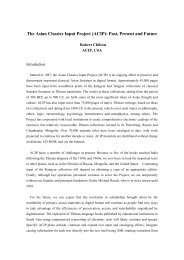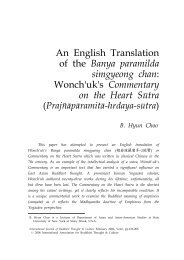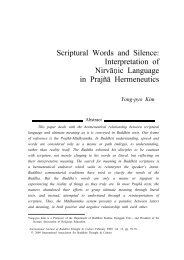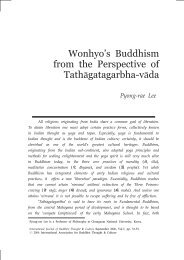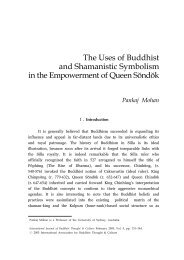Esoteric Buddhism under the KoryÅ in the Light of ... - Buddhism.org
Esoteric Buddhism under the KoryÅ in the Light of ... - Buddhism.org
Esoteric Buddhism under the KoryÅ in the Light of ... - Buddhism.org
Create successful ePaper yourself
Turn your PDF publications into a flip-book with our unique Google optimized e-Paper software.
84<br />
Henrik H. Sørensen: <strong>Esoteric</strong> <strong>Buddhism</strong> <strong>under</strong> <strong>the</strong> Koryŏ<br />
<strong>Esoteric</strong> <strong>Buddhism</strong> was <strong>the</strong> chief vehicle <strong>in</strong> handl<strong>in</strong>g <strong>the</strong> functional<br />
aspects <strong>of</strong> this “science” <strong>in</strong>clud<strong>in</strong>g <strong>the</strong> tak<strong>in</strong>g <strong>of</strong> omens, div<strong>in</strong>ation and<br />
perform<strong>in</strong>g <strong>the</strong> correct rituals, <strong>the</strong> belief-system <strong>under</strong>ly<strong>in</strong>g Koryŏ<br />
astrology was a mixture <strong>of</strong> classical Ch<strong>in</strong>ese systems <strong>of</strong> belief consist<strong>in</strong>g<br />
<strong>of</strong> a variety <strong>of</strong> philosophical and pseudo-scientific traditions which were<br />
<strong>in</strong>tegrated with a seem<strong>in</strong>gly undef<strong>in</strong>ed blend <strong>of</strong> Buddho-Daoist beliefs.<br />
While <strong>the</strong>se beliefs may have been shared by <strong>the</strong> majority <strong>of</strong> learned<br />
Buddhists, it seems all by certa<strong>in</strong> that <strong>the</strong>y were ma<strong>in</strong>ly transmitted<br />
with<strong>in</strong> <strong>the</strong> context <strong>of</strong> <strong>Esoteric</strong> <strong>Buddhism</strong>. At this stage <strong>in</strong> <strong>the</strong> research<br />
on Koryŏ astrology and related beliefs it is difficult to determ<strong>in</strong>e to<br />
which extent <strong>the</strong> Koreans had added elements <strong>of</strong> <strong>the</strong>ir own <strong>in</strong>vention to<br />
what was essentially a product <strong>of</strong> Ch<strong>in</strong>ese culture. However, without<br />
be<strong>in</strong>g too certa<strong>in</strong> <strong>of</strong> <strong>the</strong> details, I tend to consider that <strong>the</strong>y had <strong>in</strong>deed<br />
done so. Bear<strong>in</strong>g <strong>in</strong> m<strong>in</strong>d <strong>the</strong> great importance <strong>the</strong> Koryŏ k<strong>in</strong>gs ascribed<br />
to Tosŏn’s <strong>the</strong>ory <strong>of</strong> p’ungsu which was part <strong>of</strong> <strong>the</strong> same complex <strong>of</strong><br />
beliefs, it would appear that a special Korean astrology had already<br />
come about dur<strong>in</strong>g <strong>the</strong> second half <strong>of</strong> <strong>the</strong> Unified Silla period.<br />
The Indra cult was a strong and persistent element <strong>in</strong> <strong>the</strong><br />
relationship between <strong>the</strong> Koryŏ rulers and <strong>Buddhism</strong>. And as such it<br />
was unique to <strong>the</strong> Koryŏ. Moreover, I tend to believe that <strong>the</strong> Indra<br />
cult practised at <strong>the</strong> Koryŏ court throughout most <strong>of</strong> <strong>the</strong> dynasty was a<br />
sort <strong>of</strong> “cult <strong>of</strong> proxy” <strong>in</strong> <strong>the</strong> sense that <strong>the</strong> Koryŏ k<strong>in</strong>gs, as Dharma<br />
K<strong>in</strong>gs <strong>in</strong> <strong>the</strong> human realm exercised a parallel function to that <strong>of</strong> Indra,<br />
<strong>the</strong> K<strong>in</strong>g <strong>of</strong> <strong>the</strong> Gods <strong>in</strong> heaven. Here we should not f<strong>org</strong>et that <strong>the</strong>re<br />
existed chapels for Indra worship both outside and <strong>in</strong>side <strong>the</strong> royal<br />
palace <strong>in</strong> Kaesŏng which would have given <strong>the</strong> cult a special status<br />
with<strong>in</strong> <strong>the</strong> larger concept <strong>of</strong> hoguk pulgyo.<br />
Ano<strong>the</strong>r dist<strong>in</strong>ctive feature <strong>of</strong> <strong>Esoteric</strong> <strong>Buddhism</strong> <strong>under</strong> <strong>the</strong> Koryŏ<br />
was its existence as a trans-sectarian and hence unify<strong>in</strong>g current <strong>in</strong><br />
<strong>Buddhism</strong>. While <strong>Esoteric</strong> <strong>Buddhism</strong> may have been <strong>of</strong>ficially recognized<br />
by <strong>the</strong> Koryŏ k<strong>in</strong>gs and <strong>the</strong>ir courts as represented by <strong>the</strong> S<strong>in</strong><strong>in</strong> and<br />
Cho’ngji schools, <strong>the</strong> actual practice <strong>of</strong> <strong>Esoteric</strong> <strong>Buddhism</strong> went far



